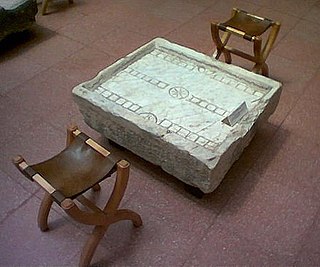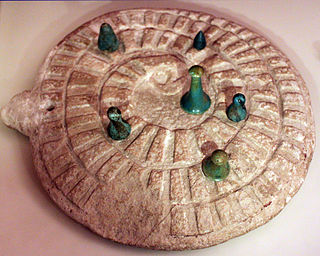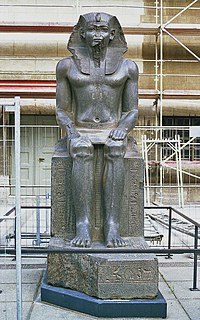Senet is an ancient Egyptian board game.
Senet may also refer to:

Ludus duodecim scriptorum, or XII scripta, was a board game popular during the time of the Roman Empire. The name translates as "game of twelve markings", probably referring to the three rows of 12 markings each found on most surviving boards. The game tabula is thought to be a descendant of this game, and both are tables games as is modern backgammon.
Egyptian describes something of, from, or related to Egypt.

Senet or senat is a board game from ancient Egypt. The earliest representation of senet is dated to c. 2620 BCE from the Mastaba of Hesy-Re, while similar boards and hieroglyphic signs are found even earlier. The game fell out of use following the Roman period, and its original rules are the subject of conjecture.
The 31st century BC was a century which lasted from the year 3100 BC to 3001 BC.
Senat may refer to:

Mehen is a board game which was played in ancient Egypt. The game was named in reference to Mehen, a snake deity in ancient Egyptian religion.
Sennett may refer to:

Nubkaure Amenemhat II was the third pharaoh of the 12th Dynasty of ancient Egypt. Although he ruled for at least 35 years, his reign is rather obscure, as well as his family relationships.

QV66 is the tomb of Nefertari, the Great Wife of Pharaoh Ramesses II, in Egypt's Valley of the Queens. It was discovered by Ernesto Schiaparelli in 1904. It is called the Sistine Chapel of Ancient Egypt. Nefertari, which means "beautiful companion", was Ramesses II's favorite wife; he went out of his way to make this obvious, referring to her as "the one for whom the sun shines" in his writings, built the Temple of Hathor to idolize her as a deity, and commissioned portraiture wall paintings. In the Valley of the Queens, Nefertari's tomb once held the mummified body and representative symbolisms of her, like what most Egyptian tombs consisted of. Now, everything had been looted except for two thirds of the 5,200 square feet of wall paintings. For what still remains, these wall paintings characterized Nefertari's character. Her face was given a lot of attention to emphasize her beauty, especially the shape of her eyes, the blush of her cheeks, and her eyebrows. Some paintings were full of lines and color of red, blue, yellow, and green that portrayed exquisite directions to navigating through the afterlife to paradise.

Tutenstein is an American animated television series, produced by Porchlight Entertainment for Discovery Kids based on the comics by Jay Stephens. The series premiered on November 1, 2003 and ended on October 11, 2008. It features young mummy Tutankhensetamun who is awakened about 3,000 years after his accidental death and now must face the fact that his kingdom is gone. The name is a portmanteau of Tutankhamun and Frankenstein.
IAH may refer to:

The Theban Tomb TT60 is located in Sheikh Abd el-Qurna, part of the Theban Necropolis, on the west bank of the Nile, opposite to Luxor. It is the burial place of a woman called Senet. She was related to the ancient Egyptian Vizier Intefiqer. It is one of the earliest burials in the area.
Tem or TEM may refer to:
AAT or Aat may refer to:
The ancient Egyptian Game piece (hieroglyph), also a Token, or the general term for any gaming-gambling piece, Draughtsman is an ancient hieroglyph. Gaming pieces were certainly required in predynastic times, as the cultural creation of games and entertainment has a long history in most cultures. An ivory-piece lion is known from the Old Kingdom of ancient Egypt; the set contains three lions, and three dog tokens of ivory.
In ancient Egyptian world, men who married to Princesses became King. Most of the time, they have to be one of royal members to get marriage to Princesses.
User may refer to:

Hounds and jackals is the modern name given to an ancient Egyptian game that is known from several examples of gaming boards and gaming pieces found in excavations. The modern game was discovered by Howard Carter, who found one complete gaming set in a Theban tomb of ancient Egyptian pharaoh Amenemhat IV that dates to the 12th Dynasty. The latter game set is one of the best preserved examples and is today in the Metropolitan Museum of Art in New York. He called it "Hounds contra Jackals". Another, less often used modern name is "fifty-eight holes".

Nile: An Ancient Egyptian Quest is a 1997 educational point-and-click adventure game developed by American studio Stone House Productions and published by Simon & Schuster Interactive for Windows 95. Players rescue three pharaohs – of the Old, Middle, and New Kingdoms – by immersing themselves into ancient Egyptian culture and life. In the UK, it was published by Zablac Entertainment. The game is no longer available.
Senet was an Ancient Egyptian king's wife and king's mother, known from three statues, that date to the Middle Kingdom, perhaps to the 12th Dynasty. Her husband and royal son are not known for sure. The statues show the queen sitting on a throne. For two of the statues the upper part is missing. A third statue preserves the upper part but the face is heavily damaged. Gae Callender proposed king Amenemhat II as her husband, as his wife is not yet identified for sure, while for most other 12th Dynasty kings a wife is known.